War in Ukraine Update: Trump's "let them fight a while" a shockingly dangerous take
Yes, it's time for another crime-and-grime update—much has been, and much continues to be in play since the last time we met.
That said—that time is going to need to wait. For despite massive coverage due to supposed (very supposed) ceasefire talks, as well as the ingenious Ukrainian deep drone strike on Russian air power—it would be remiss to entirely skip over developments in the East.
In part because said coverage (again) misses a number of key points.
But before we dive in, I would also be remiss to explain why I have been increasingly unwilling to cover the war. Put simply, most of the news has been bad news, and (as any reader should by now know), I am firmly on the Ukrainian side of the conflict.
In other words, I do no want to seem, or be accused of being, defeatist.
That caveat made loud and clear… let’s dive in, and be warned, once again, I’m going to tell it like it is. Or how I believe it is.
And once again, I’m going to hope that I’m wrong.
The focus here will once again be on the northern front, ranging from Pokrovsk to Kupiansk to Sumy. For it is the Pokrovsk to Sumy logistics line that I have long believed to be key to the outcome of the war, but Russia’s determination to make Ukraine pay for the now abandoned Kursk incursion is whole-hearted and dangerous.
First, a quick review.
Below is a map of the overall front—which may tell you little, but at least it gives and outline of the general geography of what we are talking about.
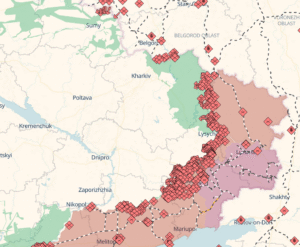
Now more to the point. For more than 18 months I have emphasized the Pokrovsk to Kupiansk supply lines. Now it should be said that this is a simplification in that the Ukrainians have proven adept at using backroads, farm roads, dirt paths and anything in between to somehow keep front line soldiers at the front. But bearing this in mind, below is a map from March that clearly shows the general distribution connections north from Pokrovsk (the blue circle at the bottom of the blue line).
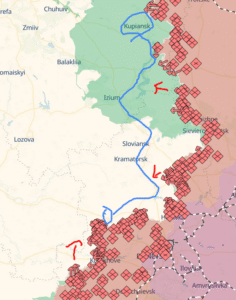
In this map (above) the roads are not particularly visible, but the run roughly up to Konstiantynivka to Sloviansk and Kramatorsk then to Izium and up to Kupiansk.
Below are two maps from March that are clearer views of that line.
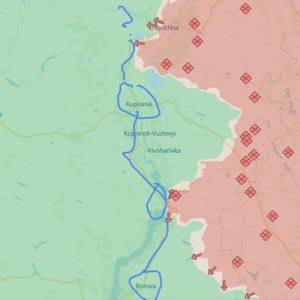
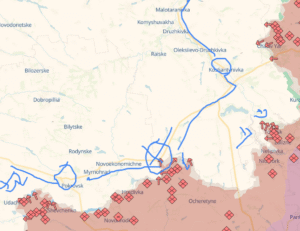
Additionally, below is the Kursk salient from March 12, with the blue representing Ukrainian held territory.
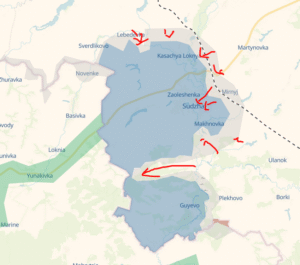
Now flash forward slightly. In the immediate wake of the ridiculous live press briefing in which US President Donald Trump and US Vice-President J.D. Vance harangued Ukrainian President Volodymyr Zelenskyy for his lack of faith in Russian President Vladimir Putin… I painted a bleak picture or Ukraine. This was chiefly because the US suddenly decided to cut off aid and briefly blind Ukraine by cutting off access to satellite intelligence feeds. At the time I wrote that this would dramatically tip the scale in Russia’s favour—and that should such antics continue, Pokrovsk would be endangered, as well as the entirety of Ukrainian holdings from Pokrovsk to Kupiansk due to said logistics lines.
Unfortunately, this prediction has largely come to fruition. Although Ukraine has at times boasted small gains, at Pokrovsk and Toretsk, for example, Russia has used constant pressure and meat waves to wear down troops, many who have hardy had a break for three years.
Yet there is more to this. Russian glide-bomb tactics are well known, but more recent tactics of using meat waves PRIOR TO glide bombs together with drones to force Ukrainian troops to reveal themselves has proven morbidly effective. In essence, Ukrainian soldiers respond to what are practically suicide attacks only to be hit hard by drones, glide bombs and lancets while lancets and drones also target reinforcements. This leaves front line troops cut off, and if they manage to survive hellacious bombardments, the meat waves begin again.
What this also means is that often there is only one option—pull out as soon as the first meat waves (who are often on motorcycles, but often are backed up by tanks and armoured vehicles) come charging in.
The end result has meant that Russia is making gains along various fronts. Sumy is under tremendous pressure. Kupiansk is under pressure. The drive to Borova has slowed, but in reality, my previous prediction is unfortunately playing out. This goes back to Pokrovsk. Despite small Ukrainian victories at Pokrovsk and brief, but small gains at Toretsk, the maps below reveal what is a frightening reality, this being that the logistics lines that enabled the defensive of the northern sectors from Pokrovsk to Kupiansk are disrupted. This can be see most immediately north of Pokrovsk in the Kramatorsk-Konstiantynivka sector, but Borova up to the Oskil waterway barrier to Kupiansk cannot be underestimated.
These Russian gains/Ukrainian losses can be seen below.
First, is shown Sumy (which once featured the Ukrainian operation in Kursk--use the town of Sudzha for orientation).

Below is the current situation, as of June 5, from Kupiansk south to Borova and also from Pokrovsk to the north.
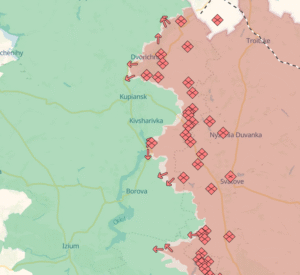
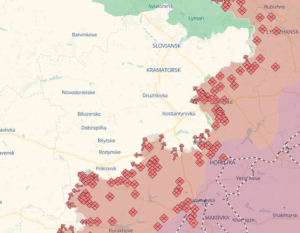
Obviously, there have been bright spots. Operation Spiderweb—an ingenious drone strike that supposedly destroyed up to 34 percent of Russia’s strategic bomber fleet was destroyed—was a clear win when Ukraine needed it most, as arguably, even the loss of a few planes could slow Russian cruise missile attacks.
Yet estimates of 41 planes destroyed were probably high (and note that the Ukrainian SBU claimed that this number was hit, not destroyed—but the true number may be as few as 13.
Meanwhile, as is the norm, Russian President Vladimir Putin has tried to impress upon Trump that Ukraine is war-mongering and not only responsible for derailing any kind of peace process, but also for literal train derailments in Kursk.
Russia has made clear that it will respond to Ukraine’s operation Spiderweb, and Ukraine has made clear that drone attacks will become more advanced, more audacious and will continue. The EU has meanwhile made clear that it will (finally) up aid to Ukraine, although this is arguably being led by a non-EU nation in the form of the UK. But what about Trump?
In truth, Trump-the-enigma remains as such. Reports by various media noted that he admired the Ukrainian attack, reportedly calling it “badass,” but in a meeting with German Chancellor Friedrich Merz he compared Russia and Ukraine to two children fighting, suggesting that sometimes “it’s better to let them fight a while” as otherwise it’s too difficult to pull them apart.
This ignores the reality on the ground. Ukraine does not “have a while,” and it is fighting for its life. The average age of soldiers on the front remains in the early forties, but troops are exhausted, and there seems to be little ability (or equipment) to properly change younger soldiers and insert them into front lines—and recent Russian meat-wave-and-bomb tactics are yet to be overcome.
At the same time, Russia is throwing still more troops into widespread attacks (reports range from 50,000 to 200,000), and further real breakthroughs, while still local, such as that which appears to have taken place in Toretsk are a threat.
In short, nothing is static. The bandied about mantra (or hopes) that the skies were now so full of drones that a breakthrough by the Russians was impossible simply is no longer true (and nor are Russian beliefs that bombers can be parked safely out of range of Ukrainian attacks). This war has produced one sea change after another for military observers and militaries the world over, but on the ground these are real soldiers, and Ukrainian cities are populated by real people who are dying on a daily basis.
Which means that a phrase such as “it’s better to just let them fight a while” is not only mistaken, but it is no less than sinfully grotesque.
Preston Smith is a licensed investigator based in Gdansk, Poland. He can be reached at query@cddi.pl.
Maps courtesy of DeepstateUA.
Lead photo: During Operation Spider's Web an FPV drone filmed the attack on Tu-22 type bombers at Belaya air base. Date 4 June 2025. Source: https://ssu.gov.ua/novyny/sbu-pokazala-unikalni-kadry-spetsoperatsii-pavutyna-u-rezultati-yakoi-urazheno-41-viiskovyi-litak-stratehichnoi-aviatsii-rf-video: Author: Security Service of Ukraine.


